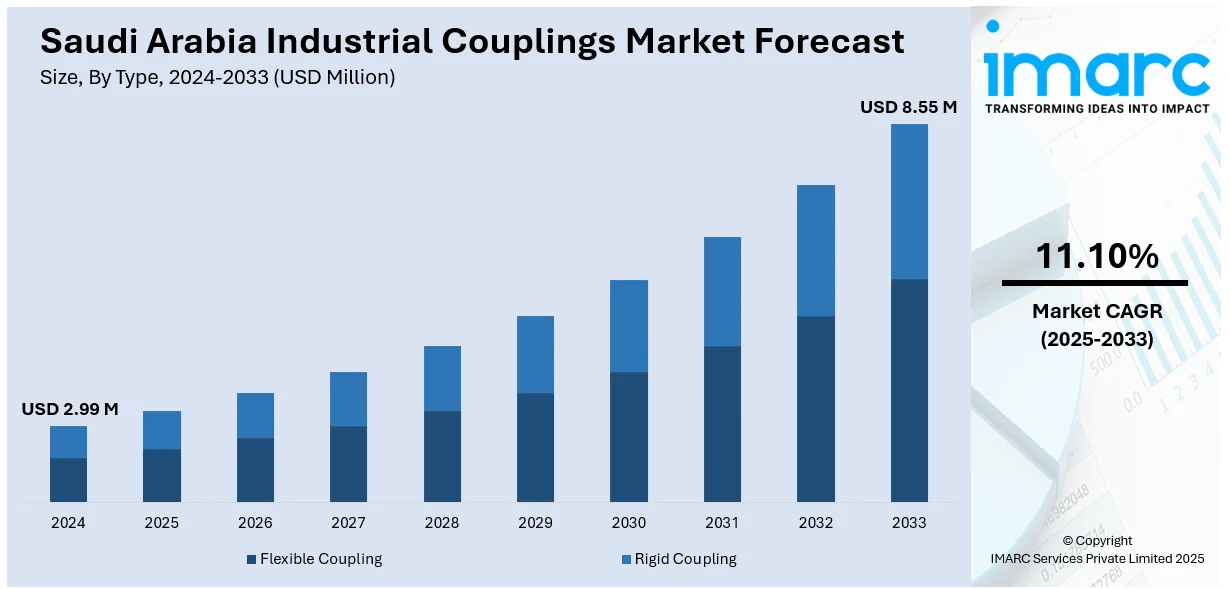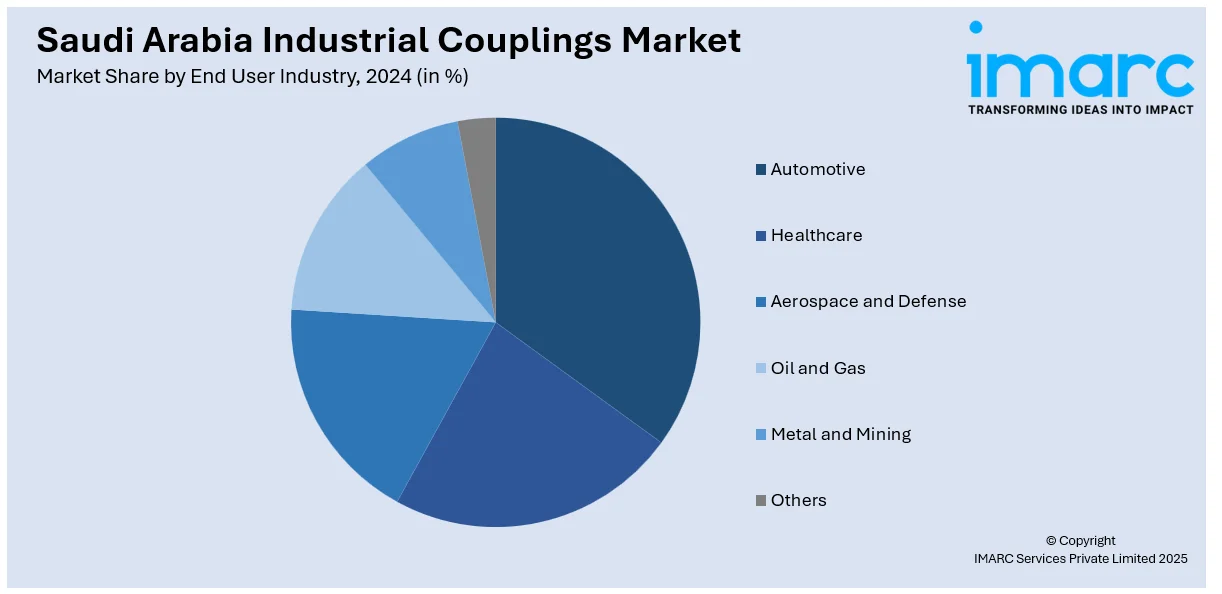
Saudi Arabia Industrial Couplings Market Size, Share, Trends and Forecast by Type, End User Industry, and Region, 2025-2033
Saudi Arabia Industrial Couplings Market Overview:
The Saudi Arabia industrial couplings market size reached USD 2.99 Million in 2024. Looking forward, IMARC Group expects the market to reach USD 8.55 Million by 2033, exhibiting a growth rate (CAGR) of 11.10% during 2025-2033. The market is being driven by increased industrial activity, localization under Vision 2030, and growing demand from sectors like oil, gas, and power. Recent facility expansions and product innovations are further supporting growth. Furthermore, these trends are contributing to the rising Saudi Arabia industrial couplings market share.
|
Report Attribute
|
Key Statistics
|
|---|---|
|
Base Year
|
2024
|
|
Forecast Years
|
2025-2033
|
|
Historical Years
|
2019-2024
|
| Market Size in 2024 | USD 2.99 Million |
| Market Forecast in 2033 | USD 8.55 Million |
| Market Growth Rate 2025-2033 | 11.10% |
Saudi Arabia Industrial Couplings Market Trends:
Growth in Oil and Gas and Petrochemical Projects
Saudi Arabia’s large and evolving oil and gas and petrochemical sectors are primary drivers for the industrial couplings market growth, as these industries require heavy-duty, reliable power transmission components for compressors, pumps, turbines, and drilling equipment. As per the IMARC Group, the Saudi Arabia petrochemicals market size reached USD 6.0 Billion in 2024. Couplings that provide torsional flexibility, misalignment compensation, and vibration damping are critical to maintain uptime and prevent catastrophic failures in continuous-process plants. With the Kingdom investing in refinery upgrades, petrochemical expansions, and maintenance of aging infrastructure, the demand for high-performance metallic and elastomeric couplings is rising. These projects often specify industrial-grade couplings with certifications for hazardous environments, high temperatures, and corrosive conditions.

To get more information on this market, Request Sample
Expanding Local Supply Chain and Service Ecosystem
The maturation of local supply chains, logistical networks, and technical service ecosystems in Saudi Arabia is supporting the growth of the market by improving product availability, lead times, and after-sales support. According to an economic report issued by the Madinah Chamber of Commerce and Industry, by the end of 2024, there were 2,817 commercial registrations in the Madinah transport and storage sector of Saudi Arabia, up from 970 in 2019. This indicated that the logistics sector grew significantly during 2019-2024. International manufacturers are partnering with local distributors for warehousing, technical training, and emergency support, enabling faster response to industrial needs. Local workshops offering refurbishment, dynamic balancing, and on-site installation services reduce downtime and encourage the replacement of substandard components with certified couplings. Training programs build capacity among local engineers and maintenance teams, increasing trust in higher-spec products.
Industrialization and Infrastructure Diversification under Vision 2030
Saudi Arabia’s Vision 2030 economic diversification program is expanding non-oil industries, such as manufacturing, logistics, mining, and construction, which in turn is catalyzing the demand for industrial couplings across multiple applications. According to the government officials, in 2024, Saudi Arabia's construction industry had tremendous expansion, adding 3,800 new licenses in a single year, bringing the total to 8,900. As new factories, industrial parks, and heavy infrastructure projects are being developed, there is a rising need for mechanical power transmission components used in conveyors, compressors, fans, and gearboxes. Local content requirements and incentives for domestic manufacturing are encouraging the establishment of assembly and supply chains that include coupling production or local distribution partnerships. Furthermore, foreign direct investment (FDI) brings international equipment standards and long-term service contracts, increasing the demand for certified, high-reliability coupling solutions.
Key Growth Drivers of Saudi Arabia Industrial Couplings Market:
Emphasis on Predictive Maintenance and Reliability Engineering
Increasing adoption of predictive maintenance, condition monitoring, and reliability engineering practices across Saudi industries is driving the demand for couplings designed for long service life and easy monitoring. Modern couplings often integrate with vibration sensors, torque monitoring, and alignment tools to provide real-time feedback on drivetrain health. Plant engineers preferring condition-based maintenance over reactive repairs seek couplings that facilitate quick inspections, simple field balancing, and modular replacement, reducing downtime during planned maintenance windows. As industries are aiming to optimize overall equipment effectiveness (OEE), investments in higher-quality couplings that lower lifecycle costs are becoming justifiable. Additionally, service providers offering alignment and coupling diagnostics are creating recurring revenue streams and strengthening buyer confidence.
Technological Advancements and Product Innovations
Ongoing technological innovations in materials, design, and manufacturing processes are expanding the utility and appeal of modern couplings in Saudi Arabia. Developments, such as composite hubs, high-performance elastomers, engineered polymer-laminated elements, and precision-machined metallic couplings, offer improved torsional properties, lower moment of inertia, and enhanced fatigue life. Advanced coatings and corrosion-resistant materials extend service life in harsh desert and petrochemical environments. Additionally, modular, torque-limiting, and safety couplings enhance machine protection in critical applications. Suppliers incorporating finite-element design, 3D machining, and automated quality control can offer more reliable, standardized products. Innovations also reduce maintenance time through easier disassembly and improve compatibility with condition-monitoring devices. Overall, these advancements are enabling end-users to select couplings optimized for energy efficiency, noise reduction, and operational safety.
Replacement and Aftermarket Demand from Aging Equipment
A significant portion of Saudi Arabia’s industrial base includes legacy equipment that requires refurbishment, spare parts, and modernization. Aging pumps, gearboxes, and compressors often need coupling replacements due to wear, fatigue, or obsolete designs. During equipment upgrades or capacity expansions, operators prefer to replace worn couplings with modern equivalents that offer better alignment tolerance, reduced vibration, and longer intervals between maintenance. The aftermarket also benefits from services, such as field alignment, coupling balancing, and emergency replacements, creating opportunities for distributors and service partners. Moreover, procurement cycles for spare parts are frequent in industries with continuous operations, sustaining recurring revenue for coupling manufacturers and service firms. This steady aftermarket demand provides a durable baseline for the market growth independent of new capital projects.
Saudi Arabia Industrial Couplings Market Segmentation:
IMARC Group provides an analysis of the key trends in each segment of the market, along with forecasts at the country and regional level for 2025-2033. Our report has categorized the market based on type and end user industry.
Type Insights:
- Flexible Coupling
- Rigid Coupling
The report has provided a detailed breakup and analysis of the market based on the type. This includes flexible coupling and rigid coupling.
End User Industry Insights:

- Automotive
- Healthcare
- Aerospace and Defense
- Oil and Gas
- Metal and Mining
- Others
A detailed breakup and analysis of the market based on the end user industry have also been provided in the report. This includes automotive, healthcare, aerospace and defense, oil and gas, metal and mining, and others.
Regional Insights:
- Northern and Central Region
- Western Region
- Eastern Region
- Southern Region
The report has also provided a comprehensive analysis of all the major regional markets, which include Northern and Central Region, Western Region, Eastern Region, and Southern Region.
Competitive Landscape:
The market research report has also provided a comprehensive analysis of the competitive landscape. Competitive analysis such as market structure, key player positioning, top winning strategies, competitive dashboard, and company evaluation quadrant has been covered in the report. Also, detailed profiles of all major companies have been provided.
Saudi Arabia Industrial Couplings Market News:
- March 2025: John Crane obtained three asset management contracts in Saudi Arabia, strengthening its position in essential equipment services. This advancement bolstered the need for industrial couplings by enhancing equipment efficiency, minimizing downtime, and broadening maintenance-related services, favorably influencing the growth of Saudi Arabia’s industrial couplings market.
- December 2024: ABB purchased Solutions Industry & Building (SIB), boosting its range of cable glands, couplings, and accessories. This action enhanced ABB’s presence in industrial, railway, and hazardous sectors across areas like the Middle East, fostering innovations.
Saudi Arabia Industrial Couplings Market Report Coverage:
| Report Features | Details |
|---|---|
| Base Year of the Analysis | 2024 |
| Historical Period | 2019-2024 |
| Forecast Period | 2025-2033 |
| Units | Million USD |
| Scope of the Report |
Exploration of Historical Trends and Market Outlook, Industry Catalysts and Challenges, Segment-Wise Historical and Future Market Assessment:
|
| Types Covered | Flexible Coupling, Rigid Coupling |
| End User Industries Covered | Automotive, Healthcare, Aerospace and Defense, Oil and Gas, Metal and Mining, Others |
| Regions Covered | Northern and Central Region, Western Region, Eastern Region, Southern Region |
| Customization Scope | 10% Free Customization |
| Post-Sale Analyst Support | 10-12 Weeks |
| Delivery Format | PDF and Excel through Email (We can also provide the editable version of the report in PPT/Word format on special request) |
Key Benefits for Stakeholders:
- IMARC’s industry report offers a comprehensive quantitative analysis of various market segments, historical and current market trends, market forecasts, and dynamics of the Saudi Arabia industrial couplings market from 2019-2033.
- The research report provides the latest information on the market drivers, challenges, and opportunities in the Saudi Arabia industrial couplings market.
- Porter's five forces analysis assist stakeholders in assessing the impact of new entrants, competitive rivalry, supplier power, buyer power, and the threat of substitution. It helps stakeholders to analyze the level of competition within the Saudi Arabia industrial couplings industry and its attractiveness.
- Competitive landscape allows stakeholders to understand their competitive environment and provides an insight into the current positions of key players in the market.
Key Questions Answered in This Report
The industrial couplings market in Saudi Arabia was valued at USD 2.99 Million in 2024.
The Saudi Arabia industrial couplings market is projected to exhibit a CAGR of 11.10% during 2025-2033, reaching a value of USD 8.55 Million by 2033.
The growing demand for reliable mechanical power transmission solutions in heavy machinery, petrochemicals, and construction sectors is fueling the adoption of industrial couplings. Technological advancements in couplings for durability, efficiency, and flexibility are also supporting the market growth, while government initiatives to diversify the economy under Vision 2030 are creating new opportunities in non-oil industries.
Need more help?
- Speak to our experienced analysts for insights on the current market scenarios.
- Include additional segments and countries to customize the report as per your requirement.
- Gain an unparalleled competitive advantage in your domain by understanding how to utilize the report and positively impacting your operations and revenue.
- For further assistance, please connect with our analysts.
 Request Customization
Request Customization
 Speak to an Analyst
Speak to an Analyst
 Request Brochure
Request Brochure
 Inquire Before Buying
Inquire Before Buying




.webp)




.webp)












